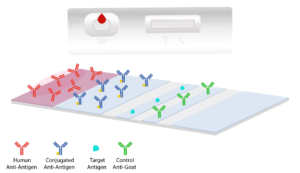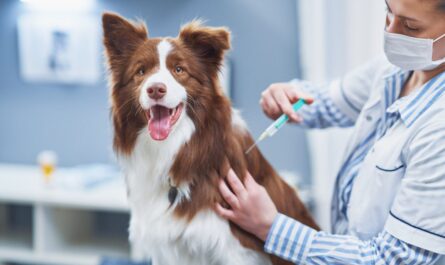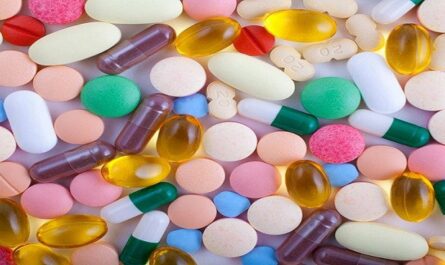
Lateral flow assays, also known as lateral flow immunochromatographic assays, are a common medical diagnostic testing method used to detect the presence or absence of targeted substances in biological samples such as blood or urine. These rapid testing kits are inexpensive, easy to use, and provide results within 30 minutes. With the ability to provide quick results outside of a laboratory setting, lateral flow assays have numerous applications in various fields including disease diagnosis, food safety testing, and drug detection.
The Basics of Lateral Flow Testing
Lateral flow assays work based on capillary action. The test consists of a strip of nitrocellulose membrane with different areas or “zones” containing various reagents. At one end is the sample pad where the liquid sample is applied. As the sample travels across the membrane via capillary action, it encounters the reaction zone containing antibodies specific to the target antigen. If the target antigen is present, it binds to the antibodies forming antigen-antibody complexes. These complexes then move further along the membrane where they are captured by a second immobilized antibody-protein conjugate, forming a visible colored line to indicate a positive result. The control line contains antibodies that capture unbound conjugate to show that the test worked properly. The entire process takes 15-30 minutes and results can be visually interpreted.
Applications in Healthcare Testing
In the healthcare sector, lateral flow assays are commonly used for point-of-care testing in doctor’s offices, hospitals, and even at home. Popular medical applications include pregnancy tests, strep throat tests, urinary tract infection tests, influenza tests, and lately COVID-19 rapid antigen tests. Their portability and ease of use allow for testing to be conducted anywhere without requiring a clinical laboratory. This makes them ideal screening tools in medical facilities and emergency rooms to quickly diagnose patients and guide appropriate treatment decisions. Lateral flow assays have also found applications in detecting other infectious diseases like malaria, dengue, tuberculosis, and HIV/AIDS in resource-limited settings.
Uses in Food Safety Monitoring
Foodborne illness poses a major public health concern worldwide. To ensure food safety, lateral flow testing kits are employed by food manufacturers, processors and regulatory agencies to screen for pathogens, allergens, GMOs and other contaminants in foods. Common targets detected include Salmonella, Listeria, E.coli, aflatoxins, grains, fish species and allergenic proteins like peanuts, milk, and eggs. The quick test results allow producers to identify contamination issues rapidly and take corrective actions like product recalls before the contaminated food reaches consumers. Regulatory agencies also use these portable kits for on-site inspections at farms, processing plants and importing ports.
Drug Detection Applications
With the ongoing drug abuse epidemic, lateral flow drug tests play a crucial role in various sectors. Law enforcement agencies rely on these test strips and cups to screen suspects for illegal and prescription drug use during traffic stops, investigations and at borders. Workplaces use drug tests to check employees and maintain safety. The military and sports organizations employ drug testing to ensure compliance with anti-doping policies. Home testing kits are also available for personal drug use monitoring. Common targets detected include marijuana, opiates, cocaine, methamphetamines and other recreational drugs from urine, blood, saliva or sweat samples. The discrete, quick results assist in addressing the drug problem in sensitive environments.
Research and Point-of-Care Diagnostics
Scientists are continuously working to expand the range of analytes that can be detected using lateral flow methods. Ongoing research aims to push the limits of sensitivity to detect biomarkers for earlier disease detection. Areas of active investigation include cancer biomarkers, cardiac markers, and infectious agent proteins. Besides in-vitro diagnostics, efforts are underway to adapt the technology for other applications like food pathogen detection kits suitable for field use. As portable lab testing becomes more advanced, scholars envision a future where personalized, real-time health monitoring becomes possible anywhere through integrated lateral flow biosensors. The simplicity and rapid readout of these assays continue fuelling innovations for point-of-care applications worldwide.
Quality Control Considerations
While lateral flow assays offer an inexpensive, easy-to-use format, quality assurance is crucial, especially in medical diagnostic applications. Variables like membrane flow properties, reagent concentrations and compatibility with sample matrices can impact test accuracy. Strict quality control procedures during manufacturing help ensure lot-to-lot consistency and limit defects. Independent validation studies evaluate analytical performance parameters like sensitivity, specificity and reproducibility using clinical samples. Proper storage and handling at recommended temperatures ensures test components retain integrity over the shelf life. User-friendly instructions aim to minimize technician errors during testing. Regular proficiency testing programs assess lab personnel skill in lateral flow method interpretation.Overall, with robust quality measures, lateral flow assays deliver reliable, actionable results.
Concluding Thoughts
Since their introduction in the 1970s for home pregnancy testing, lateral flow assays have revolutionized point-of-care clinical diagnostics, food safety monitoring and more. Their low-cost, easy to use format allows for mass screening and prompt decision making outside laboratory environments. While continual technological advancements are expanding the scope of targets detectable, the basic working principle remains the same – capillary flow combined with antigen-antibody reactions. With portability, speed and accuracy, lateral flow testing empowers the fields of healthcare, biodefense, forensics and more. Undoubtedly, lateral flow assays will keep playing a pivotal role as simple, yet powerful analytical tools.
*Note:
1. Source: Coherent Market Insights, Public sources, Desk research
2. We have leveraged AI tools to mine information and compile it


